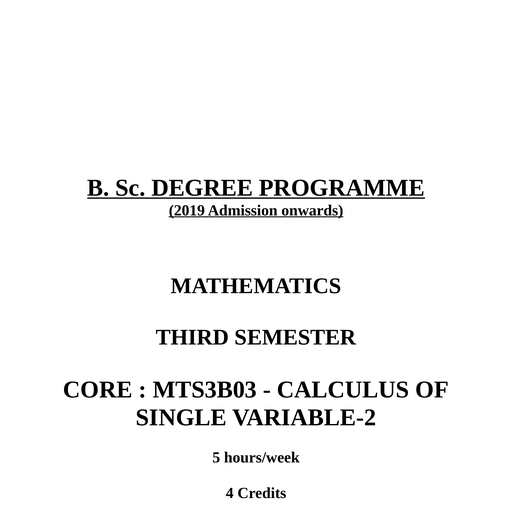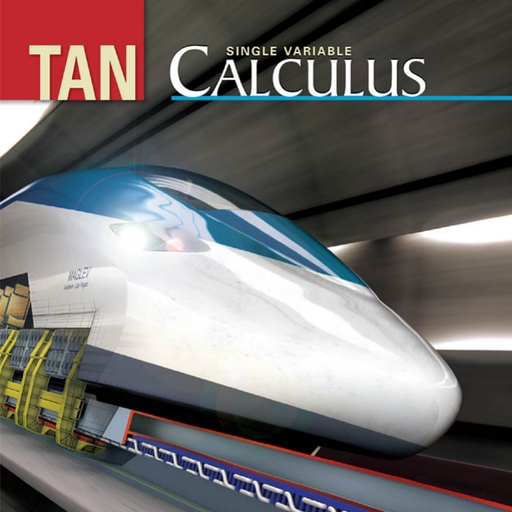Page 1 :
B. Sc. DEGREE PROGRAMME, (2019 Admission onwards), , , , MATHEMATICS, , FIFTH SEMESTER, , CORE : MTS5S B07 NUMERICAL, ANALYSIS, , 4 hours/week, , 3 Credits, , 75 Marks [Int:15 + Ext:60]
Page 2 :
| Manassas, | BEAN ae Un aes, , , , Aims, Objectives and Outcomes, , The goal of numerical analysis is to provide techniques and algorithms to find approximate, numerical solution to problems in several areas of mathematics where it is impossible or hard to find, , the actual/closed form solution by analytical methods and also to make an error analysis to ascertain, the accuracy of the approximate solution. The subject addresses a variety of questions ranging from, the approximation of functions and integrals to the approximate solution of algebraic,, transcendental, differential and integral equations, with particular emphasis on the stability,, accuracy, efficiency and reliability of numerical algorithms. The course enables the students to, , e Understand several methods such as bisection method, fixed point iteration method, regula, falsi method etc. to find out the approximate numerical solutions of algebraic and, transcendental equations with desired accuracy., , e Understand the concept of interpolation and also learn some well known interpolation, techniques., , e Understand a few techniques for numerical differentiation and integration and also realize, their merits and demerits., , e Find out numerical approximations to solutions of initial value problems and also to, understand the efficiency of various methods., , 36
Page 3 :
Syllabus, , , , , , , , Text Numerical Analysis (10/e): Richard L. Burden, J Douglas Faires,, , Annette M. Burden Brooks Cole Cengage Learning(2016), ISBN:978-1-305-25366-7, , , , , , , , , , Module-! (28 hrs), , , , , , Solutions of Equations in One Variable, Note: Students should be familiar with concepts and definitions such as, ‘round off error’, rate of convergence ‘etc. discussed in sections 1.2 and 1.3, , Introduction, , 2.1: The Bisection Method, , 2.2: Fixed-Point Iteration, , 2.3: Newton’s Method and Its Extensions- Newton’s Method (NewtonRaphson method), Convergence using Newton’s Method, The Secant Method,, The Method of False Position, , 2.4: Error Analysis for Iterative Methods- Order of Convergence, linear and, quadratic convergence, Multiple Roots, Modified Newton’s method for faster, convergence, , [Algorithms are omitted], , Interpolation and Polynomial Approximation, Introduction, , 3.1: Interpolation and the Lagrange Polynomial- motivation, Lagrange, Interpolating Polynomials, error bound, , 3.2: Data Approximation and Neville’s Method- motivation, Neville’s Method,, recursive method to generate Lagrange polynomial approximations., , 3.3: Divided Differences- k*" divided difference, Newton’s divided difference, formula, Forward Differences, Newton Forward-Difference Formula,, Backward Differences, Newton Backward-Difference Formula, Centered, Differences, Stirling’s formula., , [Algorithms are omitted], , 37
Page 4 :
Module-Il (18 hrs), Numerical Differentiation and Integration, , Introduction, , 4.1: Numerical Differentiation- approximation of first derivative by forward, difference formula, backward difference formula, Three-Point Formulas, ThreePoint Endpoint Formula, Three-Point Midpoint Formula [ Five-Point Formulas,, Five-Point Endpoint Formula, Five-Point Midpoint Formula omitted] Second, Derivative Midpoint Formula to approximate second derivative, Round-Off, Error Instability, , , , , , 4.3:Elements of Numerical Integration-numerical quadrature, The, Trapezoidal Rule, Simpson’s Rule, Measuring Precision, Closed NewtonCotes Formulas, Simpson’s Three-Eighths rule, Open Newton-Cotes, Formulas, , 4.4: Composite Numerical Integration-composite Simpson’s rule, composite, trapezoidal rule, composite midpoint rule, round off error stability, , 4.7:Gaussian Quadrature-motivation, Legendre Polynomial, Gaussian, Quadrature on Arbitrary Intervals, [Algorithms are omitted], , Module-lll (18 hrs), , Initial-Value Problems for Ordinary Differential Equations, Introduction, 5.1 The Elementary Theory of Initial-Value Problems, , 5.2: Euler’s Method- derivation using Taylor formula, Error bounds for Euler, Method, , 5.3: Higher-Order Taylor Methods- local truncation error, Taylor method of, ordernand order of local truncation error, , 5.4: Runge-Kutta Methods- only Mid Point Method, Modified Euler’s Method, and Runge-Kutta Method of Order Four are required. /derivation of formula, omitted in each case], , 5.6: Multistep Methods- basic idea, definition, Adams-Bashforth Two-Step, Explicit Method, Adams-Bashforth Three-Step Explicit Method, AdamsBashforth Four-Step Explicit Method, Adams-Moulton Two-Step Implicit, Method, Adams-Moulton Three-Step Implicit Method, Adams-Moulton, , 38
Page 5 :
Four-Step Implicit Method, Predictor-Corrector Methods [derivation of, formula omitted in each case] [Algorithms are omitted], , 1 | Kendall E. Atkinson, Weimin Han: Elementary Numerical Analysis(3/e), John Wiley & Sons(2004) ISBN:0-471-43337-3[Indian Edition by Wiley India ISBN:, 978-81-265-0802-0], , 2 |James F. Epperson: An Introduction to Numerical Methods and, Analysis(2/e) John Wiley & Sons(2013)ISBN: 978-1-118-36759-9, , 3 | Timothy Sauer: Numerical Analysis(2/e) Pearson (2012) ISBN: 0-32178367-0, , 4 |S S Sastri : Introductory Methods of Numerical Analysis(5/e) PHI, Learning Pvt. Ltd.(2012) ISBN:978-81-203-4592-8, , 5 | Ward Cheney,David Kincaid : Numerical Mathematics and Computing, (6/e) Thomson Brooks/Cole(2008) ISBN: 495-11475-8, , , , , , , , , , , , , , , , 39





































